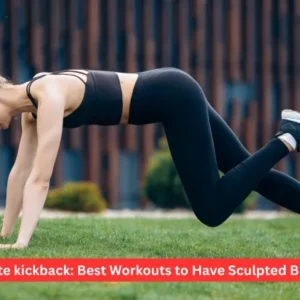Even with differing age demographics, people seem to have a similar issue with calf abdomen cramps occurring late at night. This problem appears to be a form of “Charley Horse” cramps, where the calves, hamstrings, or upper thigh muscles flex subconsciously, resulting in tightness or pain. They often cause discomfort and sleep disruption. Generally speaking, the reason behind this problem is usually related to the posture of the head and arms, which happens to block the lower back nerves. Sometimes, they are also attributed to muscle fatigue, dehydration, and electrolyte deficiency. The article below aims to describe multidimensional calf stretches that will alleviate cramping discomfort alongside suggestions on how to incorporate them into your routine to halt chronic cramping.
Understanding Leg Cramps and Their Causes
The muscle cramps that occur at night are mostly in the calf muscles, which are lying, sitting, or moving into specific lying-down positions. Maintaining a muscle in a shortened position for long periods leads to tightening, which can result in cramping. With regard to the rest of the body, the lower back plays a major role in how muscles function in relation to the sciatic nerve and other surrounding nerves. This difficulty can be alleviated with stretches that target the hamstrings, calves, and lower back muscles.
Apart from muscle posture, dehydration or low levels of calcium, potassium, or magnesium can also lead to cramps. These minerals that aid in muscle contraction and relaxation make a person more susceptible to muscle cramps. Cramping is an issue that is common to many people. Fortunately, the positive side is that there are some stretching exercises that can help decrease the chances of cramping.
Key Stretches for Relieving Calf Cramps
The following exercises are highly efficient in relieving cramps in your calf, improving flexibility, and enhancing the muscles that prevent spasms.
1. Full Body Stretch
A full-body stretch is an excellent way to work the lower back to the calves. Such exercises can help with general flexibility, lower muscle tension, increase blood circulation, and prevent cramps.
How to perform the full body stretch
- Stand in front of a step stool and place your foot on the stool or step.
- Plant your other foot, heel down, slightly behind you.
- Lower the knee of your top leg toward the ground, slowly shifting your hips to the side.
- Hold this position for 2–3 seconds and release.
- Do this stretch 10 times on each leg.
Tips:
- When bent at the knee, be careful not to let your knee go forward to your ankle.
- Tighten your core so you don’t fall out of the stretch.
The stretch hits the calves and works the hamstrings, hip flexors, and lower back, so it minimizes the chances of cramping in those areas as well.
2. Hamstring Stretch
Delos does the knee joint, hamstrings, inner thigh muscles, and knees pull leg cramps. If a stretch in the hamstring muscle fails to relieve any existing tightness, it is more likely to strain the calf muscle and the rest of the lower body muscles. Stretching your hamstrings may relieve cramps to some degree.
To achieve a hamstring stretch, follow these steps:
- Position your straight knee under your foot at the ankle level on an item such as a stool or a lower step.
- Keep the line extending from your hip to your leg perfectly straight. Now, pull your ankles up towards the knees.
- Round your back and begin moving forward until you feel some stretch around the side parts of your legs. Move as far as you feel comfortable.
- Hold the stretch for roughly ten seconds, then ease the position.
- Each leg should be completed ten times.
Important tips:
- The lower back is prone to straining; therefore, while doing the stretches, attempt to keep the back as straight as possible.
- Overstretching limits can raise stiff tissues, which can need healing. Therefore, have a moderately relaxed stretch.
In lowering or reducing cramps or in relieving tightness, lowering hamstring muscles helps loosen calf muscles.
Read more: How & Why to Focus on Your Posterior Chain muscle
3. Calf muscle stretch
Focusing on a particular stretch for calf muscles is the best way of relieving tightness of the muscles in the calf region. Improving the flexibility of cramp-affected calf muscles helps relieve pain in the future.
Methods for stretching and warming up the calves:
- Rest your back against the wall such that your feet are shoulder-width apart.
- If needed, use your hands to help you balance.
- While keeping your heels on the ground, lift your right leg.
- Bend your left knee and place it against the wall.
- Make sure to feel the stretch on the outer side of your calf muscles.
- After holding the stretch for 10 seconds, switch legs. Rinse and repeat for each leg 10 times.
Helpful Suggestions:
- To increase the strength of the stretch, you may want to move your hips toward the wall. This approach will allow for greater motion in the calves.
- To make the stretch effective, don’t bend the right foot resting on the floor.
Incorporating these stretches into your exercise routine will help relieve soreness and reduce the chances of cramps at night, after sitting for too long, or standing for long times.
Benefits of Stretching for Calf Cramps
- Adding calf and lower-body movements to your regimen may offer many benefits, including:
- Enhancing flexibility: Loosening the muscles in the hamstrings, calves, and lower back may result in greater flexibility and make everyday activities less painful.
- Improved Blood Flow: Stretching will help improve blood flow to your muscles and reduce muscle stiffness or help prevent muscle cramps from developing.
- Reduced Muscle Tightness: Regularly stretching can help those muscles relax and not get too tight and sore.
- Injury prevention: Stretching can help avoid injury by promoting muscle flexibility and elasticity. Stretching could potentially alleviate the pain caused by sudden or long-term absence during racing.
Other Tips for Preventing Calf Cramps
You can reduce the likelihood of suffering from calf cramps by following these suggestions:
- Keep hydrated: Dehydration can cause cramps. Stay hydrated as you go through your day. Particularly when you’re engaged in sport.
- Keep a balanced diet: Make sure to eat enough potassium, magnesium, and calcium. They are essential for the proper function of your muscles.
- Wear the right footwear: Poor footwear can lead to cramps in your legs. Choose shoes with adequate support, especially if you will be standing or walking for a long time.
- Massage Your Muscles: Before bedtime, you can reduce the risk of cramps and tension by massaging your calves.
- Avoid sitting or standing in one position for long periods of time: If you can, change your posture often to prevent putting too much stress on your muscles.
Conclusion – Calf Stretches for Cramps
Calf cramps are relatively common; they can be treated and avoided through the right mix of stretching, hydration, and lifestyle adjustments. The exercises, like the whole body and calf stretch, are aimed at the main muscles involved in leg cramps. Including these exercises in your daily routine can help decrease muscle tension, promote flexibility, and prevent the discomfort and pain of cramps from disrupting sleep or your daily schedule. And if you practice them regularly, these four simple but powerful techniques can do wonders for relaxing tight calf muscles and improving circulation throughout your legs.








4 thoughts on “Effective Calf Stretches for Cramps: Prevent and Relieve Night Leg Cramps Naturally”
I as well as my friends have already been checking out the good helpful tips from your website then the sudden developed a terrible feeling I had not expressed respect to the website owner for them. All of the young boys became as a result excited to learn them and have in effect in fact been taking pleasure in those things. Many thanks for really being very accommodating as well as for having certain helpful subjects most people are really desperate to learn about. Our sincere apologies for not saying thanks to you sooner.
Thank you so much — really glad you and your friends found the tips helpful! Your kind words mean a lot to me. 🙏😊
Excellent read, I just passed this onto a friend who was doing a little research on that. And he just bought me lunch because I found it for him smile Thus let me rephrase that: Thank you for lunch!
You’re very welcome! Glad I could help, and enjoy your lunch! 😊